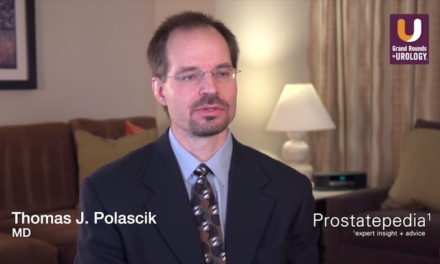Dr. Thomas J. Polascik presented “Current Findings on High Intensity Focused Ultrasound (HIFU)” at the 27th annual International Prostate Cancer Update meeting on Wednesday, January 25, 2017.
Keywords: prostate cancer, gland, HIFU, ablations, focal therapy, biopsy
How to cite: Polascik, Thomas J. “Current Findings on High Intensity Focused Ultrasound (HIFU). January 25, 2017. Accessed Jul 2025. https://grandroundsinurology.com/current-findings-high-intensity-focused-ultrasound-hifu
Transcript
Current Findings on High Intensity Focused Ultrasound (HIFU)
I’d like to review the current findings on high intensity focused ultrasound. And I’ll start by speaking on selection and outcomes for whole gland treatment, and we will then go into focal ablation, and then a few comments with salvage HIFU.
Regarding general selection criteria, the ideal gland volume is less than 40 cc with minimal calcifications that would interfere with the transmission of sound waves. As noted in the whole gland HIFU series, larger glands can be downsized with the pre-procedural TURP or neoadjuvant ADT, particularly to reach anterior lesions. The anterior lesions can be particularly troublesome at HIFU because of the longer distance from the probe, and also energy absorption by intervening tissue as well as some of the progressive edema that one gets during treatment.
Also, HIFU is a time-dependent treatment, and it works quite well for focal because you are treating a smaller volume. Post-treatment includes interval PSA, MP or MRI, but treatment success is ultimately defined by negative biopsies of the post-ablation zone typically done 6 to 12 months after treatment. The publish experience of HIFU for whole gland primary treatment for prostate cancer is derived from retrospective reviews at several large, international centers. And here you see the five largest published series, each including over 500 treated patients with long term follow-up as long as 14 years.
The selection criteria that was reported in the whole gland series includes good life expectancy, and greater than 95% of the cases in each of these series are T2 or lower except for the most recent report by Dickinson et al, whereby 15% of the cases were T3 lesions, but none were metastatic. And up to 14% of the cases in each series were Gleason 8 or higher. All series’ used Abotherm except for the one by Dickinson which used Sonoblate. You can note here the differences in gland volume. And this also has to do with downsizing with ADT or TURP. Preoperative ADT was administered anywhere from 13% to 59% in each series, and there was a wide variability in the use of preoperative downsizing TURP.
Two centers performed TUR before most ablations while the other groups in general did not. Oncologic efficacy is measured with post-treatment biopsies. Biochemical recurrence, the need for salvage intervention and survival; the definition of biochemical disease free survival was based on the Phoenix criteria for most of these reports. Regarding biopsy, there was a wide variation in the number of patients undergoing post-treatment biopsy ranging from 32% in the Dickinson study up to 83% in the Uchida series.
The rate of positive biopsies in these five series ranged from 13% to 47%. Patients that required salvage therapy was typically less than 20%, although it was reported to be as high as 34% in men with high risk disease who were treated. Cancer-specific survival was greater than 97% in all series who reported on this outcome. And it’s worth noting that overall survival in the Munich series that comprised 78% of men with intermediate high risk disease features was comparable to the general male Bavarian population during the same study period.
So overall, as you can see here, we had a very favorable low PSA nadir. And in terms of functional outcomes, preservation of erectile function in preoperatively potent men ranged anywhere between 25% to 55%. Regarding continence, Dickinson et al reported that 88% of the patients free before treatment remained so in similar fashion after HIFU. Reports of grade II or higher incontinence was limited to less than 5%. The Sebastian and Crouzet and group reported the placement of an artificial urinary sphincter in 3% in a male sling [phonetic] in 2% of the patients.
Regarding complications, the most reported complication was bladder outlet obstruction, and including bladder neck contracture, urethral stenosis, and this occurred in up to 28% of the cases. Fistula occurred in less than 0.7%, and it was associated with early treatment here and also repeat procedures, and the need for secondary interventions endoscopically was as high as 24% to 30%.
Regarding primary focal ablation according to a recent consensus meeting published in 2015 on focal therapy, all risk categories can potentially be treated focally. However, in the case of low risk patients, it should really only be due to the patient refusing active surveillance or feeling uncomfortable with it, also perhaps the patients who drop out of active surveillance due to psychological factors. Focal therapy can be entertained if there is a lesion to be seen and ablated.
For high risk patients on the other side of the spectrum, metastases were to be ruled out, and the sweet spot is the intermediate risk patient who were considered the best candidates, particularly for a targetable lesion that is present. And one of the principles is that potentially if the Gleason 7 is ablated, this can recirculate the patient back into the active surveillance pool.
As we heard this morning, mpMRI is the ideal tool to characterize the localized lesions fit for focal therapy. It’s important for treatment planning, size, location, suspicion score, and the proximity to critical structures. All lesions should be mapped out in a three dimensional space, and all radiographically suspicious lesions should be biopsied and confirmed before being ablated.
The quality, as Scott told us this morning, is also paramount. 3T is ideal. At Duke we use a three heat plus an endorectal coil. You need a good reader, and I will show you a study we did in terms of over-reading MRI’s. For the patients with a positive biopsy but a non-suspicious MRI, we performed transperineal-mapping biopsies, and I know the UCLA group does as well. This is done through the 5 mm grid template; it has a very high fidelity for localizing clinically significant cancers.
There is still no consensus, though, if multiparametric MRI can substitute for TTMB, which is especially used for, again, if there is no visible radiographic lesion. Again, mpMRI at this point is considered the best imaging modality for planning and follow-up, but there are a few downsides to this as well that need to be kept in mind. And this is from the FDA. They had a panel the other year, but the sensitivity is low at only 47%. And as was mentioned this morning, it tends to underestimate the tumor volume by 0.5 cc. There was a study in the Journal of Urology this past month that talks about a good majority of the volume may be missing with multiparametric MRI, even in the centers of excellence reported by the UCLA group.
Contemporary outcomes of focal HIFU ablation are derived from studies, and typically performed in trial settings many of which utilize hemiablation, just like the cryotherapy trials. The cohorts include both Sonablate and Ablotherm for the most part with one trial reporting on the use of a new focal one machine. There are eight published series of patients treated in the last decade with focal HIFU totaling 357 patients. The largest group is 111 from Rischmann, which represents a multi-institutional registry initiated by the French Urological Association.
Most limit to localized disease and less than a Gleason 3+4. The recent index ablation case by Ahmed et al included two patients with T3a disease. All other series were limited to T2 tumors, and there is a small subset of patients with high-risk disease included in three of these studies. Most include staging mpMRI with or without template biopsy, and then mpMRI reevaluation after treatment with re-biopsy again between 6 and 12 months following HIFU.
One of the benefits of focal treatment is that neoadjuvant hormones where pretreatment TURP is typically not performed in contrast to whole gland therapy. Now most studies presented here are based on hemiablation just like Dr. Jones talked about for focal cryo. Post-treatment biopsy outcomes were reported in seven of these series. Feijoo et al noted 84% negative biopsy rate in the treatment zone at 12 months with an overall negative biopsy rate of 75% when including out of field positive biopsies.
Rischmann and co-workers on the negative biopsies were greater than 90% in both the treated and the untreated lobes, and 14 men went on to curative intent HIFU surgery or radiation. Only one study incorporated the use of HIFU to target the index lesions reported by Ahmed and co-workers. They noticed a high positive biopsy rate at 42% because they were doing a very coned down treatment. Ahmed et al noticed that 15% had residual clinically significant disease in the follow-up biopsy in the treated zone with an additional two patients outside of the treated zone.
In terms of functional parameters, these series reflect the advantage of a focal approach for preservation of erectile function and urinary continence. Almost all studies report on preserved erectile function of greater than 75% in preoperative potent patients, and the continence rate of over 95%. The complications, urinary tract infection, retention, self-resolving dysuria and hematuria were the most common. There was a single report of a fistula that was thought to be a fistula that was successfully managed in a conservative manner. Endoscopic intervention occurred in 5% in Ahmed’s index ablation series.
This is an interesting report coming from van Velthoven’s group reporting the results of their hemi HIFU ablation technique, and they matched that to unilateral cancer in the patients who underwent robotic prostatectomy. This was a mass peer analysis and they were matched for Gleason PSA clinical stage, and all unilateral cancer. And they looked at the outcome as salvage-free therapy survival. They said it wasn’t significantly different between surgery and hemiablation. But the HIFU group did have higher rates of preserved potency and urinary continence.
Switching gears to salvage HIFU; as a comparison, whole gland salvage HIFU for radio recurrent prostate cancer has demonstrated short term oncological outcomes comparable to other modalities, but with similarly high side effects. Murat et al reported a progression free survival at three years, and 53% for low risk patients; 42% for intermediate; and 25% for high risk. Urinary incontinence was noted in 48%, and 11% of those men required the artificial urinary sphincter.
In terms of focal salvage cryo, Ahmed et al tried to spare the apex to preserve the external sphincter to potentially reduce incontinence. He performed salvage hemi or quadrant ablation in 39 patients, and demonstrated three year biochemical disease free survival in 63% with 64% of the patients being pad free, and 87% overall pad free. One fistula was noted. Baco et al delivered hemi salvage HIFU to 48 men following radiation confined to one lobe MRI. The progression free survival at 24 months was 52% and overall 75% of the men were pad free. Four developed bilateral recurrence, four had recurrence in the untreated lobe, six had metastatic disease, and two had PSA only recurrence.
This is a recent multi-institutional retrospective study on post-radiation salvage HIFU comprising 418 men which demonstrated good short term oncologic control with a cancer specific survival of 82%, and post-treatment PSA nadir of 0.19. That was achieved after a mean of ten weeks. And you can see at the bottom at seven years 82% cancer specific survival and 81% metastasis free survival. In the same study, Sebastian Crouzet and co-workers looked at factors associated with salvage HIFU failure and recurrence. And they found that the ones that were noted were a history of ADT use, pre-salvage Gleason score, and the pre-salvage PSA level.
A study from Shaw et al, this is published in July 2016 on salvage HIFU, showed that post-HIFU PSA nadir was the best predictor of overall survival. And, for example, the progression free survival when including all of the patients was 72%. You can see that here at one year, but when you look at only the people who responded, i.e. those that had achieved a PSA nadir, the progression free survival improved to 86% at one year.
Another recent prospective series regarding salvage HIFU also identified PSA nadir of less than 0.5 as reported in the previous study by Shaw et al was a significant predictor of biochemical relapse and freedom of survival. The five year overall survival was 88%, and the cancer specific survival was 94%. From a functional point of view, the latest salvage HIFU series reporting continence ranges ranging from 3% to 31% because a high rate of bladder outlet obstruction with one series demonstrating the need for bladder neck incision in 54% of the men.
The fistula rates ranged between 0.6% to 9%, and erectile function in general was worse following treatment. So, in summary, for whole gland there is a good cancer specific survival, but a high─ post-HIFU positive biopsy rate. High rates of bladder neck contracture that require intervention, and for focal ablation MRI is necessary. Short and midterm outcomes look promising, but longer follow-up in prospective trials are necessary. And regarding salvage ablation, PSA nadir is associated with biochemical relapse free survival, and we need better techniques to minimize some of these side effects. Thank you.
ABOUT THE AUTHOR
Thomas J. Polascik, MD, FACS, is Professor of Surgery at Duke University Medical Center and the Director of Surgical Technology at the Duke Prostate and Urological Cancer Center. He is the Founder and Co-Director of the International Symposium on Focal Therapy and Imaging of Prostate and Kidney Cancer, which began at Duke in 2008. Dr. Polascik is the Editor of Imaging and Focal Therapy of Early Prostate Cancer. He is Founder and President of the Focal Therapy Society, as well as Director of Duke’s Society of Urologic Oncology Fellowship Training Program and the Genitourinary Program on Focal Therapy at the Duke Cancer Institute. He is the Medical Director of Duke’s Men’s Health Initiative Screening Event and is a governing member of several medical boards and societies. His clinical and research interests focus on prostate and kidney cancer. He has authored over 350 peer-reviewed manuscripts and book chapters.




